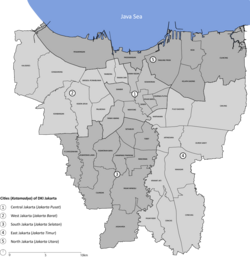Jakarta Cathedral
| Jakarta Cathedral Gereja Katedral Jakarta Kathedraal van Jakarta | |
|---|---|
| The Church of Our Lady of the Assumption Gereja Santa Maria Diangkat ke Surga De Kerk van Onze Lieve Vrouwe ten Hemelopneming | |
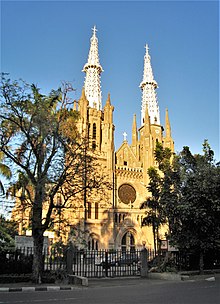 | |
| 6°10′09″S106°49′59″E/ 6.169257°S 106.833069°E | |
| Location | Sawah BesarSubdistrict,Central Jakarta,DKI Jakarta,Indonesia |
| Denomination | Roman Catholic |
| Religious institute | Jesuit |
| Website | http://www.katedraljakarta.or.id/ |
| History | |
| Status | Cathedral |
| Consecrated | 21 April 1901 |
| Architecture | |
| Architect(s) | Antonius Dijkmans,SJ |
| Style | Gothic Revival |
| Groundbreaking | 1891 |
| Completed | 1901 |
| Construction cost | 628,000 Dutch Guldens (in 1891) |
| Specifications | |
| Length | 60 metres (200 ft) |
| Width | 10 metres (33 ft) |
| Height | 60 metres (200 ft) |
| Number ofspires | 3 |
| Spire height | 60 metres (200 ft) |
| Materials | bricks covered with plaster, teak roof construction, and iron construction spires. |
| Administration | |
| Archdiocese | Archdiocese of Jakarta |
| Deanery | Central Jakarta |
Jakarta Cathedral(Indonesian:Gereja Katedral Jakarta,Dutch:Kathedraal van Jakarta) is aRoman CatholiccathedralinJakarta,Indonesia,which is also the seat of the Roman Catholicarchbishop of Jakarta,currentlyArchbishopIgnatius Suharyo Hardjoatmodjo.[1]Its official name isGereja Santa Maria Diangkat ke Surga,derived from the original name in Dutch,De Kerk van Onze Lieve Vrouwe ten Hemelopneming(English:The Church of Our Lady of the Assumption). This current cathedral was consecrated in 1901 and built in theneo-Gothicstyle, a common architectural style to build churches at that time. The Jakarta Cathedral is located inCentral JakartanearMerdeka SquareandMerdeka Palace,right in-front of the cathedral stands theIstiqlal Mosque.
History[edit]

After the arrival ofDutch East India Companyin 1619, the Roman Catholic Church was banned in the Dutch East Indies and was limited toFloresandTimor.The Netherlands was known to supportProtestantismand tried to limit the influence and authority of theHoly See.During theFrench Revolutionary Warsand theNapoleonic Wars,the Netherlands,including the Dutch East Indies and its other colonies, fell under the control ofRevolutionary Franceand later theFrench Empire.In 1806,Napoleoninstalled his Catholic younger brotherLouis Napoleon(Dutch:Lodewijk) as the King ofHolland.Since then, the Catholic Church has been free to operate in the Dutch East Indies.[2]
The commissary general ofBatavia,Du Bus de Gisignies (1825–1830), was credited with providing land to build the first Catholic church in Batavia. The former residence of General de Kock in the Weltevredeen area was renovated to be a church. Monseigneur Prinsen blessed and inaugurated the church on 6 November 1829 and named it "Our Lady of the Assumption." The church was renovated in 1859, but collapsed on 9 April 1890.[2]
The present church is the structure that was rebuilt between 1891 and 1901. Pastor Antonius Dijkmans, SJ was appointed as the architect. Construction was halted due to a lack of funding, but the church's new bishop, Mgr E. S. Luypen, SJ, raised the necessary funds in the Netherlands, and architect MJ Hulswit resumed construction in 1899.[3]"De Kerk van Onze Lieve Vrowe ten Hemelopneming - The Church of Our Lady of the Assumption" was blessed and inaugurated by Mgr Edmundus Sybrandus Luypen, SJ on 21 April 1901. The church was renovated between 1988 and 2002.[2]
A tunnel connecting the church andIstiqlal Mosquewas constructed between 2020 and 2021.[4][5]
Architecture[edit]
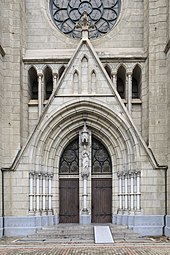

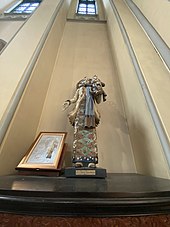
The plan of the cathedral took the form of a cross with a length of 60 meters and 10 meters wide, plus 5 metres on each aisle. It is a cathedral because it contains the "cathedra",the throne ofbishop.The main entrance of the building is facing west. At thetrumeauof the main portal stands a statue ofOur Ladywhile on top of the portal there is a sentence written inLatin:"Beatam Me Dicentes Omnes Generationes"which means "All generations shall call me blessed". Besides, there is a large round stained glassRozeta Rosa Mystica,which is the symbol of Mother Mary.[1]
There are three main spires in Jakarta Cathedral: the two tallest ones measured 60 metres tall and are located in front on each side of the portal. The north tower is calledTurris Davidica,or "Tower of David" —a devotional title of Mary symbolizing Mary as the refuge and protector against the power of darkness. The south tower, also 60 metres tall, is called "The Ivory Tower", which the whiteness and pureness of ivory describe the pureness of the Virgin Mary. On the Ivory Tower, there are old clocks that are still functioning as well as a church bell. The third spire rises above the roof's cross intersection and measured 45 metres tall from the ground, and is called "The Angelus Dei Tower".[1]
The building consists of two floors, the upper floor can be reached from a flight of stairs in the northern tower. Originally, the second floor used to be the place for thechoirduring masses, but since the cathedral is quite old, there is concern that the building cannot support the weight of too many people upstairs. Today, the upper floor functions as the Jakarta Cathedral Museum, housing the relics of Catholic rituals, such as the silver cups, hats and robes of theDutch East Indiesand Indonesian archbishops and cardinals.[6]The museum also displays the history ofRoman Catholicism in Indonesia.[1]
On the southern side, there is a statue ofPietà,describing the sadness of Mother Mary while holding the body of Jesus Christ after the crucifixion. The wall surrounded the interior has several scenes depictingStations of the Cross.The cathedral has four pulpits forconfessionservices, two on each side. At the centre, there is a high raised wooden podium with shell-shaped roof for sound reflection. The podium was installed in 1905 and display the images of Hell on the lower side while the images of Jesus' sermons and other scenes are on the middle side. The top of the podium displays the scene of Heaven adorned with wingedangels.On the southern side, there is a large neo-Gothic styleorganmade in Verschueren, Belgium, then moved and installed in Jakarta in 1988. This organ was taken from Amby village near Maastricht.[1]
There are three altars in this cathedral: on the left side is "The Altar of Saint Mary", to celebrate the assumption of Mary to Heaven. The altar was made in 1915 by Atelier Ramakers. On the right side is "The Altar of Saint Joseph", completed in May 1922. The throne of the bishop, called thecathedra,is located on the left side with three thrones. The main altar located in the centre was made in the 19th century in the Netherlands. It was moved from aJesuitchurch in Groningen in 1956. In this altar, there is a main cross of Jesus and the tabernacle.[1]
The body of the building was made of thick red bricks covered with plaster and applied with patterns to mimic natural stone construction. The large wall was made to support wide-spanned teak beams in the roof construction. The top of the spires was made from the iron frame, while the roofs were made of teak wood construction. Iron and wood are not suitable as typical neo-Gothic architecture materials usually employ stone masonry. However, these materials were chosen because they are relatively lighter than stone masonry, considering Indonesia is a region that is prone to earthquakes.[1]
Music[edit]
There is a piano, twoelectones,and two playable pipe organs.
Pipe organ[edit]
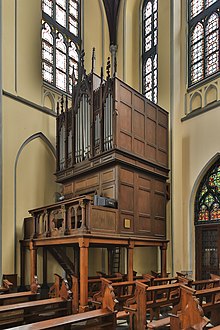
On an elevated platform in the south transept sits an organ made by George Verschueren ofTongeren,Belgium, built in 1988. Draw stops were arranged on each side of the key desk and wind was activated from a stop on the left side. Manuals are of four octaves and the flat pedalboard of two-and-a-half octaves. The organ loft railing and organ casework reflect the gothic nature of the cathedral and all timbers are stained to match the existing woodwork of the church. Pipes are presented in flats with a large central tower and two flanking small towers in the left and right extremities of the case.[7]
The stoplist of the organ is:
Manual I(56 notes/4 octaves)
- Gamba 8'
- Bourdon 8'
- Flute 8'
- Nazard 2 2/3'
- Gemshorn 2'
- Trumpet 8'
Manual II(56 notes/4 octaves)
- Bourdon 16'
- Open Diapason 8'
- Stopped Diapason 8'
- Octave 4'
- Fifteenth 2'
- Sesquieltera rk Bass
- Sesquieltera rk Treble
- Mixture IV ranks
Pedal(30 notes/2 1/2 octaves)
- Subbass 16'
- Open Wood 8'
Coupler
- I + II
- P + I
- P + II
Gallery[edit]
-
The cathedral duringmass
-
Aconfessionalroom
-
Jakarta CathedralPietà
-
Thestoupof the cathedral, with a memorial stone to Marius Hulswit
See also[edit]
- List of church buildings in Indonesia
- List of colonial buildings and structures in Jakarta
- Christianity in Indonesia
- Catholic Church in Indonesia
References[edit]
- ^abcdefgMuseum Gereja Katedral (2005).Sejuta Pesona Gereja Katedral Jakarta(in Indonesian). Jakarta: Gereja St. Maria Diangkat ke Surga, Paroki Katedral Jakarta.
- ^abcPerjalanan Iman Gereja Katedral(in Indonesian). Jakarta: Museum Katedral. 2008.
- ^"1891 – 1901".Paroki Katedral Jakarta(in Indonesian).Retrieved12 November2020.
- ^"Jokowi Bangun 'Terowongan Silaturahmi' Istiqlal-Katedral".CNN Indonesia(in Indonesian). 7 February 2020.Retrieved7 February2020.
- ^"Terowongan Silaturahmi Istiqlal-Katedral Rampung, Begini Penampakannya".Kompas.com(in Indonesian). 21 September 2021.Retrieved26 March2022.
- ^Lutfi Rakhmawati (7 March 2012)."Cathedral Museum Counts on Volunteers".The Jakarta Post.Retrieved26 March2022.
- ^"Katedral Katolik".Pipe Organs of Indonesia.Retrieved26 March2022.

